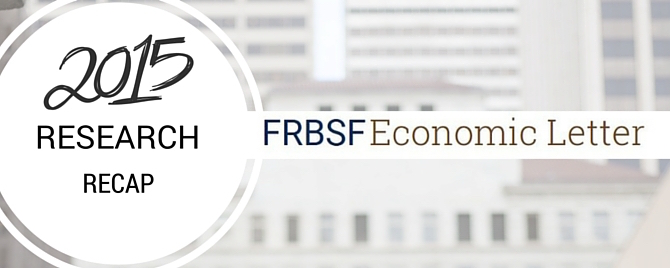Economic growth, wages, and housing prices were trending online for Federal Reserve Bank of San Francisco Economic Research in 2015. Here’s a roundup of the year’s most popular Economic Letters from SF Fed economists.
- The Puzzle of Weak First-Quarter GDP Growth
Glenn D. Rudebusch, Daniel Wilson, and Tim Mahedy
May 18, 2015The official estimate of real GDP growth for the first three months of 2015 was shockingly weak. However, such estimates in the past appear to have understated first-quarter growth fairly consistently, even though they are adjusted to try to account for seasonal patterns. Applying a second round of seasonal adjustment corrects this residual seasonality. After this correction, aggregate output grew much faster in the first quarter than reported.
- Why Is Wage Growth So Slow?
Mary C. Daly and Bart Hobijn
January 5, 2015Despite considerable improvement in the labor market, growth in wages continues to be disappointing. One reason is that many firms were unable to reduce wages during the recession, and they must now work off a stockpile of pent-up wage cuts. This pattern is evident nationwide and explains the variation in wage growth across industries. Industries that were least able to cut wages during the downturn and therefore accrued the most pent-up cuts have experienced relatively slower wage growth during the recovery.
- The Recent Rise and Fall of Rapid Productivity Growth
John Fernald and Bing Wang
February 9, 2015Information technology fueled a surge in U.S. productivity growth in the late 1990s and early 2000s. However, this rapid pace proved to be temporary, as productivity growth slowed before the Great Recession. Furthermore, looking through the effects of the economic downturn on productivity, the reduced pace of productivity gains has continued and suggests that average future output growth will likely be relatively slow.
- Why So Slow? A Gradual Return for Interest Rates
Vasco Cúrdia
October 12, 2015Short-term interest rates in the United States have been very low since the financial crisis. Projections of the natural rate of interest indicate that a gradual return of short-term interest rates to normal over the next five years is consistent with promoting maximum employment and stable inflation. Uncertainty about the natural rate that is most consistent with an economy at its full potential suggests that the pace of normalization may be even more gradual than implied by these projections.
- Is China’s Growth Miracle Over?
Zheng Liu
August 10, 2015The recent slowdown in China’s growth has caused concern about its long-term growth prospects. Evidence suggests that, before 2008, China’s growth miracle was driven primarily by productivity improvement following economic policy reforms. Since 2008, however, growth has become more dependent on investment and overall growth has slowed. If the recent reform plans can successfully address the country’s structural imbalances, China could maintain a solid growth rate that might help smooth its transition to high-income status.
- Interest Rates and House Prices: Pill or Poison?
Òscar Jordà, Moritz Schularick, and Alan M. Taylor
August 3, 2015Policymakers disagree over whether central banks should use interest rates to curb leverage and asset price booms. Higher interest rates make mortgages more expensive and could prevent borrowers from bidding up house prices to create a boom. However, rough calculations show that the size of rate increase needed to do so might also boost unemployment and push down inflation. Thus, using this type of policy tool may cause the central bank to deviate significantly from its goals of full employment and price stability.
- What’s Different about the Latest Housing Boom?
Reuven Glick, Kevin J. Lansing, and Daniel Molitor
November 16, 2015After peaking in 2006, the median U.S. house price fell about 30%, finally hitting bottom in late 2011. Since then, house prices have rebounded strongly and are nearly back to the pre-recession peak. However, conditions in the latest boom appear far less precarious than those in the previous episode. The current run-up exhibits a less-pronounced increase in the house price-to-rent ratio and an outright decline in the household mortgage debt-to-income ratio—a pattern that is not suggestive of a credit-fueled bubble.
- Persistent Overoptimism about Economic Growth
Kevin J. Lansing and Benjamin Pyle
February 2, 2015Since 2007, Federal Open Market Committee participants have been persistently too optimistic about future U.S. economic growth. Real GDP growth forecasts have typically started high, but then are revised down over time as the incoming data continue to disappoint. Possible explanations for this pattern include missed warning signals about the buildup of imbalances before the crisis, overestimation of the efficacy of monetary policy following a balance-sheet recession, and the natural tendency of forecasters to extrapolate from recent data.
- Can We Rely on Market-Based Inflation Forecasts?
Michael D. Bauer and Erin McCarthy
September 21, 2015A substantial decline in market-based measures of inflation expectations has raised concerns about low future inflation. An important question to address is whether these measures contain information that can improve upon alternative forecasting methods. This analysis finds that market-based inflation forecasts generally are no more accurate than surveys of professional forecasters or simple forecast rules. This suggests that financial markets can provide little additional useful forward-looking information about inflation.
- Higher Education, Wages, and Polarization
Rob Valletta
January 12, 2015The earnings gap between people with a college degree and those with no education beyond high school has been growing since the late 1970s. Since 2000, however, the gap has grown more for those who have earned a post-graduate degree as well. The divergence between workers with college degrees and those with graduate degrees may be one manifestation of rising labor market polarization, which benefits those earning the highest and the lowest wages relatively more than those in the middle of the wage distribution.
The views expressed here do not necessarily reflect the views of the management of the Federal Reserve Bank of San Francisco or of the Board of Governors of the Federal Reserve System.
